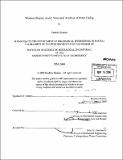Wireless bicycle assist : structural analysis of outer casing
Author(s)
Sharma, Kashika
DownloadFull printable version (3.346Mb)
Other Contributors
Massachusetts Institute of Technology. Dept. of Mechanical Engineering.
Advisor
Julio Guerrero.
Terms of use
Metadata
Show full item recordAbstract
Although cost effective and environmentally friendly, bicycles are impractical for many users due to the required strength and physical exertion. The GreenWheel is a set of mechanical and electronic devices that provide adjustable amounts of torque to a bicycle wheel to assist the rider in pedaling. This device makes bicycles accessible to a much larger fraction of the population. The device consists of two main modules, one of which is mounted on the handlebar, allowing the user a convenient way to set a desired torque output. It functions to wirelessly convey this information to the second main module, which mounts at the center of the rear wheel of the bicycle and is designed to exert a user-desired amount of torque to the wheel. The inner portion of this module contains a motor layout, including batteries, solenoids, and magnets. The outer portion of this module is a casing that rotates on bearings on the bicycle shaft. It is held in place by the spokes of the wheel that attach to the holes at the circumference of the device. Originally the device was designed to operate using brushed DC motors. Realizing the potential of brushless DC motors, brushed DC motors were abandoned in the design of the actual product that will be released in the market. This change required a complete redesign of the inner casing that stored the motor. This also created the need to redesign the outer casing to provide the device with the proper structural integrity and a more appealing and elegant design. This thesis focuses on the redesign of the outer casing, the analysis of its two critical components, and its aesthetics. One of its two critical components is the material of spoke-holes on the circumference of the outer casing to which the spokes will be attached. It was evaluated for the amount of shear that it will experience as a result of spoke tension. The second critical component is the material of the bicycle shaft to which the motor was attached. It was analyzed to prevent failure from shearing due to the electromagnetic forces created by the motor coils. In addition, aesthetics and ease of assembly and servicing were also considered in the design of the device. The area of the outer casing that surrounds the spoke-holes was analyzed using the largest amount of force that it will experience from the spokes. It was found that these areas that surround the spoke-holes are strong enough to withstand the shear stress from the spokes. The shaft was designed to withstand the torsion generated during the operation of the motor.
Description
Thesis (S.B.)--Massachusetts Institute of Technology, Dept. of Mechanical Engineering, 2009. Cataloged from PDF version of thesis. Includes bibliographical references (p. 23).
Date issued
2009Department
Massachusetts Institute of Technology. Department of Mechanical EngineeringPublisher
Massachusetts Institute of Technology
Keywords
Mechanical Engineering.